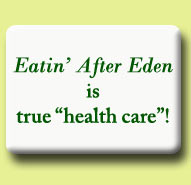10 TOP REASONS YOU NEED QUALITY MEAT
We usually make half lunch or dinner raw organically grown vegetables such as dark green lettuce, cherry tomatoes, celery, avocado, and the like. Vitamins B complex and C are water soluble, are not stored in the body, and are heat labile; destroyed when cooked, whereas fat soluble vitamins A, D, E, and K are absorbed by and stored in fats.
A Cornell University study reveals that the popular meat-free diet long term alters DNA such that people become increasingly more susceptible to inflammation proven to increase their risk for heart disease and colon cancer, the top two killers of Americans.
Grass-fed beef and lamb, moose, elk, oxen, and fatling calves1---information regarding these and all the following reasons for eating red meat, are included in Eatin' After Eden.
In Chapter 3 readers will learn about the highest quality protein, and of the fascinating experience of Dr. Vilhjalmur Steffanson who avoided any nutritional deficiency, including vitamin C found in raw, red meats, after a year of such diet..
(Pork, "the other white meat," so called by the National Pork Board for an advertising campaign to overcome indoctrination of the public against red meat in favor of chicken and turkey, was recently approved for a 150° drop in the recommended cooking temperature. The US Department of Agriculture [USDA] guidelines allow 145° F as measured by a food thermometer, with a three-minute rest time, as a "safe final internal cooking temperature." Eatin' After Eden presents serious scientific, and scriptural arguments explaining why this may not be the case after all.)
Often toddlers and young children will eat tender beef when they won't touch other meats. We alternate these nutrient-dense treats at lunch as our main meal: beef, including liver, chicken, turkey, lamb when available, and sometimes meatless main meals using complementary protein. (We no longer consume anything from the plastic-saturated ocean, including sea salt [use Utah salt instead]) Wild game (non-scavenger) is enjoyable and healthy eating as well. Breakfast usually includes eggs with cheese or grass-fed beef sausage without nitrates or sugar.
Additionally, this book explains a great deal about each of the ten reasons listed below for enjoying grass-fed, red meat a couple times per week. This book is a good starting place if you are considering vegetarianism or veganism, about which there are two powerful chapters! Except for the first two items, this listing is not in order of importance.
-
Top quality, complete protein – Chicken, turkey, fish, and other flesh foods do not have all the benefits of beef, lamb, and wild game as explained in detail in Eatin' After Eden.
-
Vitamin B12 – Beef tenderloin, calf liver, and lamb are especially high in this vitamin critical for your metabolism of the macronutrients protein, carbohydrates, and fats; support of red blood cells (anemia prevention), DNA, and nerve development. A mild deficiency of this vital nutrient can lead to fatigue, anemia, and depression. Long term deficiencies can cause permanent damage to the central nervous system.
-
Zinc – Red meat is rich in this trace mineral. If you consume primarily a plant-based diet low in bioavailable zinc, or you are an alcoholic, you may be zinc deficient. Strongly encouraged to avoid red meat high in easily absorbed zinc, and to consume ready-to-eat, high fiber, high phytates cereals and grains, in fact, Americans are commonly deficient in this trace mineral. Vital for the immune system, growth, cholesterol, sense of smell and taste, skin (acne), eye, hair, prostate, and fertility, all depend upon it. In a study reported in the American Journal of Clinical Nutrition, the zinc from beef was three times more absorbable than that found in breakfast cereal.1 The high phytates in the cereals and grains bind and inhibit the absorption of zinc. Plasma zinc levels are dependent upon vitamins A and D, of which animal sources are better absorbed. "[Z]inc deficiency may play a major, perhaps the dominant role, in causing adverse cardiac events," according to Eby and Halcomb.2
-
Stearic acid - In epidemiologic and clinical studies this saturated fatty acid is associated with lowered "bad" LDL cholesterol. It appears it may be healthier than other saturated fatty acids.3
-
Vitamin A (not the plant precursor, beta carotene) – This vitamin is closely linked to protein metabolism (the deficiency and protein malnutrition are often found together) , essential for good health, requiring fat for absorption, important for vision, bones, growth, reproduction, cell division, and cell differentiation.
-
Healthy interstitial saturated fat - This good fat is vital for our cell membranes and hormone production.
-
EPA (converted omega 3) -- "Grain-fed beef can have an omega 6:3 ratio higher than 20:1" whereas grass-fed red meat has an omega 3:6 ratio of 1:.016.4 The Creator designed cattle to consume grass, not grains. In the Bible grain was for working oxen who required high carbohydrates for energy, and walked it off.
-
Iron - Like zinc, a lack of dietary red meats, plus high intake of cereals and grains high in iron-binding phytates, add to the burden of iron deficiency. Grass-fed beef has heme iron, the organic form of iron 500% more bioavailable than non-heme iron, the form found in plant foods.
- CLA – (Conjugated linoleic acid) -- Grass-fed meat is 3-5 times higher in this incredible phytonutrient than grain-fed meat. An unsaturated fat found only in red meat interstitial, non-visible fat, whole milk and whole milk derivatives, studies show it inhibits colorectal cancer and others. Grass-fed beef appears to provide double the CLA ratio of high fat meat. "A growing body of evidence reveals it reduces the incidence, progression, and number of metastases and tumors of many kinds," "...the only fatty acid shown unequivocally to inhibit carcinogenesis in experimental animals...exhibiting consistent antitumor properties...even at very low levels..." according to the National Academy of Sciences. (See Eatin' After Eden, Chapter 5, page 106 for all references.)
- Monounsaturated fat (MUFA) – This fatty acid is also found in extra virgin olive oil and avocadoes, is heart protective, improves lipid profiles according to the American Heart Association, and reduces the risk of breast cancer according to a Swedish study.
- Carnitine protein - Red meat is the only major source of this very important body builder. Carnitine turns fat into energy. Diabetics lose it seven times faster. An antioxident, it also assists with immune functiion. A vitamin C deficiency = a carnitine deficiency.
Note too that King Soloman's court and he ate [organic] grass-fed oxen, sheep, hart, roebuck, fallow deer, and fatted fowl. (1 Kings 4:23) A number of other Scriptures also instruct and explain that the work animals not to be consumed were to be fed high-carb food; e.g., "Muzzle not the ox that grinds out the corn [grain]."
These were not the animals that are most often consumed today. In the US, non-grass fed, non-organic meats are most often fattened in unhealthy feed lots prior to market, using antibiotics to keep them alive. Most antibiotics in America are administered to animals that are consumed by humans. It leads to obesity. Thus we should consume only organic meats.
- Am J Clin Nutri;1993;58:902-7 (See also artles re tick-bite beef)
- http://www.wnho.net/angina1.htm
- Hunter, J. Edward; Zhang, Jun; Kris-Etherton, Penny M. [Jan 2010]. "Cardiovascular disease risk of dietary stearic acid compared with trans, other saturated, and unsaturated fatty acids: a systematic review".
Am.J.Clinical Nutrition [American Society for Nutrition] 91 (1): 46–63 - J Anim. Sci. 2000.78:2849-2855
EACH OF THE 11+ CHAPTERS IN EATIN' AFTER EDEN IS A STAND-ALONE-BOOK IN ITSELF—ALL FOR THE PRICE OF ONE! WHEN THE CHAPTERS ARE READ TOGETHER THERE IS A SYNERGISTIC EFFECT THAT CAN EXPONENTIALLY ENHANCE YOUR ACHIEVEMENT OF AN ADVANCED LEVEL OF WELLNESS.




